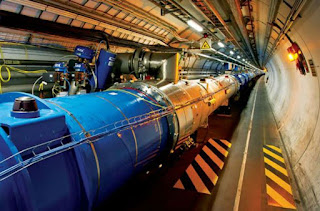Via wired.co.uk by Abigail Beall
From its beginning, the Large Hadron Collider (LHC) has captured the imagination of the world.
As the largest and most powerful machine on the planet, the 27km underground ring in Geneva is capable of answering questions we have never been able to ask before. By smashing subatomic particles together at speeds approaching the speed of light, it can confirm the existence of widely-predicted particles, discover new ones, and could potentially even create microscopic black holes that lead to other dimensions.
It is little wonder the world panicked when it first fired up more than eight years ago – with headlines describing how a black hole created by the LHC could swallow up the planet.
Much of this hysteria originated from an uncertainty regarding the machine, what it is capable of, and what it actually does. But the capability of the immense LHC is the culmination of the work of leading figures in particles physics dating back almost 100 years.
What is the LHC?
The LHC is the world’s largest example of a type of machine that started life in 1937. Particle accelerators are used by physicists to get a glimpse of the tiniest parts of our Universe. By smashing particles together at high speeds, to create high-energy collisions, particle accelerators were first used to look into the structure of an atom’s nucleus.
As technology and our understanding of physics have both advanced, particle accelerators have been getting bigger and bigger. But they still rely on the principle of using strong magnets generating electromagnetic fields to make subatomic particles move as fast as they can.
Inside the LHC, two high-energy particle beams travel at close to the speed of light before they are made to collide. The beams travel in opposite directions, guided around the accelerator ring by a strong magnetic field generated by superconducting electromagnets.
The bigger the accelerator, the faster the beams can travel and the higher energy the collisions can be. This means the further into the depths of the unknown we can delve.
The beams inside the LHC are made to collide at four locations around the huge underground ring, corresponding to the four particle detectors, named ATLAS, CMS, ALICE and LHCb.
New particles
One of the most famous examples of the LHC in action is the famous Higgs boson.
The particle was the final missing piece of what physicists refer to as the Standard Model of particle physics - a set of laws that governs particles on the most fundamental scale.
It took almost 50 years from Peter Higgs’ first calculations to its discovery in 2012. But the particle, which is said to give all other particles mass through a ubiquitous field known as the Higgs field, is not the only the beginning.
The Standard Model
The Standard Model of particle physics says everything in the Universe is made from the most basic building blocks called fundamental particles, that are governed by four forces: gravity, electromagnetic, weak nuclear and strong nuclear.
Measuring photons is one way the LHC detects new and unknown events, because photons are easy to detect. When particles decay into photons, they release energy equivalent to their mass multiplied by the speed of light squared.
Scientists are constantly searching for new particles that do not fit the model. They hope to break free of its strict guidelines, which have so far been unable to explain things like how classical and quantum physics can fit together.
Hidden dimensions
One of the strangest questions scientists are using the LHC to answer is how many dimensions there actually are. Some theories of quantum physics point towards there being more than just the three dimensions in space we deal with in our everyday lives – but this is not predicted in the Standard Model.
For example, string theory, which says the fundamental building blocks of life are made up of vibrating strings, predicts there to be nine dimensions in space and one in time.
If there are more dimensions, some argue, this might explain some mysteries of modern physics such as why gravity is so weak compared to the rest of the fundamental forces.
Theories like string theory predict the existence of certain particles that could only exist if there were more than four dimensions. By colliding particles at high enough energies, the LHC might be able to detect a glimpse of these particles.
Another way is by catching the flash of a microscopic black hole, which some theorists suggest could be the doors to alternate universes.
‘Searches for extra dimensions and black holes at the LHC have been going on since the 2000s,’ Christopher White, a theoretical physicist at Queen Mary University London told WIRED. ‘Searches for supersymmetry go back to previous experiments... and are also going on at the LHC.’
Source


No comments:
Post a Comment